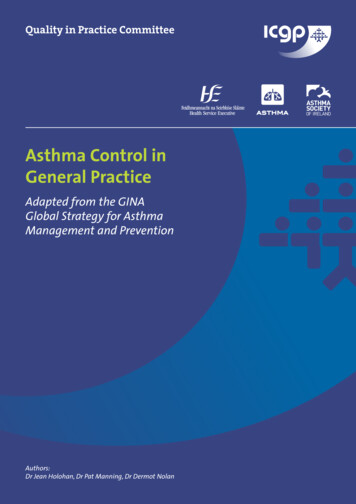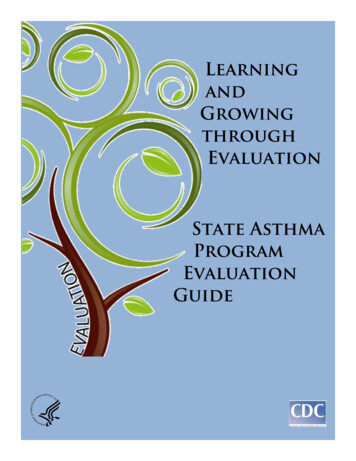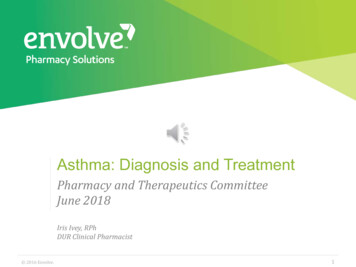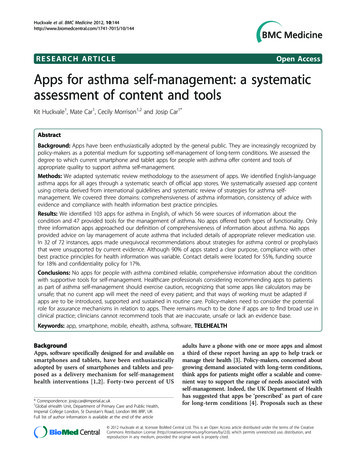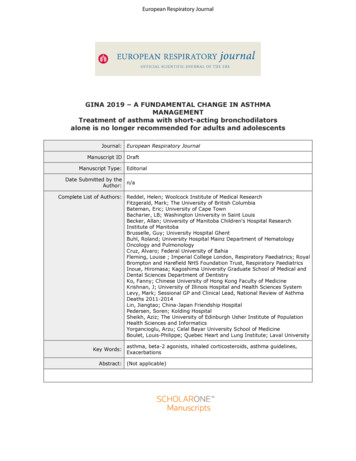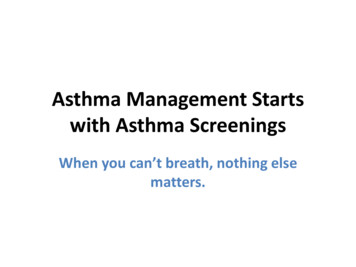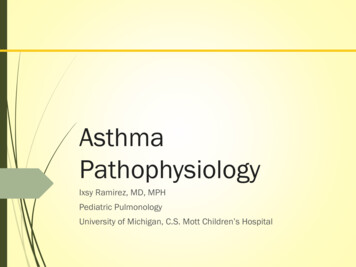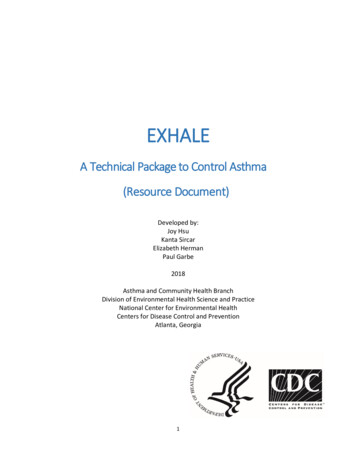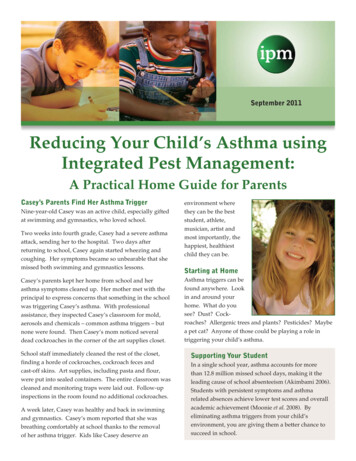
Transcription
September 2011Reducing Your Child’s Asthma usingIntegrated Pest Management:A Practical Home Guide for ParentsCasey’s Parents Find Her Asthma TriggerNine-year-old Casey was an active child, especially giftedat swimming and gymnastics, who loved school.Two weeks into fourth grade, Casey had a severe asthmaattack, sending her to the hospital. Two days afterreturning to school, Casey again started wheezing andcoughing. Her symptoms became so unbearable that shemissed both swimming and gymnastics lessons.Casey’s parents kept her home from school and herasthma symptoms cleared up. Her mother met with theprincipal to express concerns that something in the schoolwas triggering Casey’s asthma. With professionalassistance, they inspected Casey’s classroom for mold,aerosols and chemicals – common asthma triggers – butnone were found. Then Casey’s mom noticed severaldead cockroaches in the corner of the art supplies closet.School staff immediately cleaned the rest of the closet,finding a horde of cockroaches, cockroach feces andcast-off skins. Art supplies, including pasta and flour,were put into sealed containers. The entire classroom wascleaned and monitoring traps were laid out. Follow-upinspections in the room found no additional cockroaches.A week later, Casey was healthy and back in swimmingand gymnastics. Casey’s mom reported that she wasbreathing comfortably at school thanks to the removalof her asthma trigger. Kids like Casey deserve anenvironment wherethey can be the beststudent, athlete,musician, artist andmost importantly, thehappiest, healthiestchild they can be.Starting at HomeAsthma triggers can befound anywhere. Lookin and around yourhome. What do yousee? Dust? Cockroaches? Allergenic trees and plants? Pesticides? Maybea pet cat? Anyone of those could be playing a role intriggering your child’s asthma.Supporting Your StudentIn a single school year, asthma accounts for morethan 12.8 million missed school days, making it theleading cause of school absenteeism (Akimbami 2006).Students with persistent symptoms and asthmarelated absences achieve lower test scores and overallacademic achievement (Moonie et al. 2008). Byeliminating asthma triggers from your child’senvironment, you are giving them a better chance tosucceed in school.
Asthma in ChildrenIntegrated Pest Management Combats AsthmaAsthma is a health condition that causes inflammation ofthe lungs and airways. The inflammation and contractionof respiratory muscles cause a variety of symptoms.Symptoms to look for:쑺 Difficulty breathing쑺 Wheezing during exhaling쑺 Dry coughing쑺 Feeling of tightness in the chest쑺 Agitation쑺 Itching neck, throat and earsIntegrated pest management (IPM) is common sense!쑺 Find pest problems early.쑺 Improve sanitation to reduce food, water, and clutterthat attract pests.쑺 Pest-proof buildings to eliminate entry points andhiding places for pests.쑺 Use low-risk options when a pesticide is needed.Asthma TriggersMost asthma symptoms are caused by environmentaltriggers including allergens and irritants. The more achild is exposed to a trigger the greater the risk for anasthma attack (Pennsylvania IPM Program undated).Serious symptoms requiring immediate medicalattention include:쑺 Inability to speak쑺 Exhaustion쑺 Rapid heart-beat쑺 Sweating쑺 Blue lips, fingers and feetAllergens:Irritants:쑺 Cockroaches쑺 Pesticides쑺 Dust mites쑺 Cleaning products쑺 Pollen쑺 Aerosols쑺 Rodents쑺 Smoke쑺 Mold쑺 Cats, dogs and other petsWhy does IPM Alleviate Asthma Symptoms?Some pests and certain pesticides can trigger asthmaattacks in sensitive children. By using IPM to reducecommon triggers, your child will live a healthier andhappier life!IPM is much more effective at managing pests comparedwith routine application of pesticides. Many pestproblems can be completely avoided by excluding pestsand correcting the conditions that attract and supportpests. IPM reduces exposure to both pests and pesticides(Gouge et al. 2006) and has been shown to lower asthmasix times more than conventional treatments (Nalyanyaet al. 2009). The Centers for Disease Control andPrevention recommends IPM to address asthma (Centersfor Disease Control 2010).Image: chrisroll / FreeDigitalPhotos.netChildhood Asthma is on the Rise 쑺 Asthma rates rose by 75% between 1980 and 1994,and by 160% for those under four years of age(Pew Environmental Health Commission 2000).쑺 An estimated 9.6 million children (13.1%) of theU.S. population under the age of 18 have asthma(Centers for Disease Control 2007).When using IPM fewer pest problems develop into infestations and fewer pesticide applications are necessary. Byeliminating asthma triggers, your home can be a healthier place for the entire family even if you are not asthmatic.-2-
How Can You Reduce Triggers in Your Home?Pollen쑺 Avoid planting highly allergenic plants around thehouse including ash, birch, hickory, oak, juniper,pecan, privet, willow trees and ornamental Ficustrees.쑺 Mow the lawn before weeds flower to greatly reduceallergens.Follow these steps:Cockroaches쑺 Regularly clean counters, sinks, dishes, cabinets andfloors to eliminate pest access to food.쑺 Eliminate sources of water including drippingfaucets and leaking pipes.쑺 Store trash in containers with lids and emptyregularly.Copyright 2007 David MonniauxGerman cockroach (1/2 inch)Mold쑺 Clean any signs of mold with hot soapy water.쑺 Remove any sources of water and fix leaking pipes.쑺 Use exhaust fans and open windows to dry out air indamp kitchens and bathrooms.Pets쑺 Vacuum floors and furniture regularly, using aHEPA filtered vacuum.쑺 Keep pets outside when appropriate.쑺 If inside, keep pets off of furniture and out of bedrooms.쑺 Clean fish tanks to avoid mold growth.쑺 Use low-dust media and bedding in reptile and smallanimal enclosures.쑺 Wash cats and dogs regularly.Turkestan and Orientalcockroaches (1-1.75 inches)Dust Mites쑺 Vacuum weekly using a HEPA filter, vacuumfurniture, rugs, and drapes as well as carpets.쑺 Wash bed sheets, blankets and stuffed toys weeklyand fully dry before returning to the bed.쑺 Place mite-proof covers on mattresses and pillows.Rodents쑺 Seal rodent entry ways under doors, around pipesand other openings.쑺 Keep all food in air tight containers and removesources of water.쑺 Fix leaks to remove access to water.쑺 Set multiple snap traps in places where rodents areactive. Keep them from children by placing them inlocked rodent boxes. Check and reset traps dailyuntil captures stop.Image: Carlos Porto / FreeDigitalPhotos.netIndoor air quality (IAQ)쑺 Avoid using aerosols and chemical sprays, includingpesticides.쑺 Use microfiber cleaning tools to prevent allergensfrom becoming airborne.쑺 Plan for ventilation when painting and usingconstruction materials.쑺 Use exhaust fans and exterior vents to reducenitrogen dioxide from appliances such as gas andkerosene stoves (Triggers in Your Home 2011).쑺 Avoid scented candles and plug-in.Image: George Shuklin, 2008-3-
Pesticides: A Trigger and a CauseTips and ToolsTraditional pest control methods can include regularapplication of pesticides, whether pests are present or not.Evidence suggests that pesticides, like pests, can bothcause and trigger asthma (Salam et al. 2004, Field 2002).Therefore it is prudent to use only what is really needed.Shop smart. Live smart.Read pesticide labels. If you decide to purchase apesticide, read the label to help you choose the safestproduct that works for the specific pest you want tocontrol.Store pesticides in a safe place. If pesticides are stored inthe home, store them in a locked cabinet at least 4 feet upand out of reach of children.NEVER buy illegal pesticides. Only buy pesticidesfrom a retail store that are in original, sealed containers.Other products are potentially very dangerous to yourfamily.What is the Air Quality Index?Poor outdoor air quality can also trigger an asthmaattack. To view the current air quality and pollen levelsfor your area, visit www.epa.gov/airnow orhttp://www.pollen.com.What Pesticides are on Your Lawn?Not all pesticides cause asthma or trigger attacks, butsome over-the-counter products contain irritants knownto trigger people with asthma. Of 30 commonly usedlawn pesticides, 27 are irritants, meaning they have thepotential to trigger asthma symptoms (Glaser 2005).IPM Action Steps for ParentsSafe pest management practices that can lessen your child’s asthma symptoms쑺 Do not leave dirty dishes or food outover night.쑺 Store pet foods in pest-proof containersat night.쑺 Use a trash can with trash-bag and lid,and empty trash regularly.쑺 Fix water leaks, wipe up spills and remove pet’s water dishes at night.Three strikes and pests are outStrike one: Keep out.쑺 Install door-sweeps and weatherstripping on windows.쑺 Seal cracks, crevices and holes that mayallow pest entry.쑺 Replace damaged window screens.Strike two: Clear out.쑺 Get rid of things you don’t need such asold clothes, newspapers and cardboardboxes.Strike three: Watch out.쑺 Monitor the kitchen, basement and bathroom, all high-risk areas for pests.쑺 Use small sticky traps or glue boards tomonitor for pests.-4-
ResourcesMoonie, S., Sterling, D. A., Figgs, L. W., and Castro, M. 2008. Therelationship between school absence, academic performance, and asthmastatus. J. School Health 78(3): 140-148.The American Lung Association offers tips for creating an asthmaaction plan, using an asthma checklist and advice on makingtreatment decisions. For more info, go to a G., J. C. Gore, H. M. Linker and C. Schal. 2009. Germancockroach allergen levels in North Carolina schools: Comparison ofintegrated pest management and conventional cockroach control.J. Medical Entomology 46: 420–427. http://www4.ncsu.edu/ e United States Environmental Protection Agency provides webusers with an interactive quiz, information on asthma awareness monthand programs available to assist those with asthma. To learn more, visithttp://www.epa.gov/asthma/National Research Council, National Academy of Sciences. 1993.Pesticides in the Diets of Infants and Children, Washington, DC:National Academy Press. 184-185.Additional Information About Green Cleaning can be found athttp://www.informedgreensolutions.org/ l Asthma Education and Prevention Program. 2007. Guidelinesfor the Diagnosis and Management of Asthma. U.S. Department of Healthand Human Services, NIH. 415 pp.To Learn More about IPM Practices, visithttp://ipminstitute.org/faq.htm ennsylvania IPM Program at Penn State. Undated. Asthma, Pests andPesticides. University Park, PA. 2 pp. asthma-2.pdf/at download/fileReferencesAkimbami, L. J. 2006. The State of Childhood Asthma, United States,1980-2005. Advance Data from Vital and Health Statistics: no.381,Hyattsville, MD: National Center for Health Statistics, 2006.US EPA. Asthma Triggers: Gain nvironmental Health Tracking Project Team. 2000. America'sEnvironmental Health Gap: Why the Country Needs a Nationwide HealthTracking Network. The Pew Environmental Health Commission at theJohns Hopkins School of Hygiene and Public Health. May lthgap.pdf 21 pp.Centers for Disease Control and Prevention. 2007. National Health 7.Interview Survey Data. Table 1-1, Lifetime Asthma PopulationEstimates—in thousands—by Age, United States: National Health interviewSurvey, 2007. Atlanta, GA: U.S. Department of Health and HumanServices, CDC, 2010. P. 1Rosenstretch, D. L., Eggleston, P., Katten, D., Baker, D. Slavin, R. G.,Gergen, P., Mitchell, H., McNiff-Mortimer, K., Lynn, H., Ownby, D.and Malveaux, F. 1997. The role of cockroach allergy and exposure tocockroach allergen in causing morbidity among inner-city children withasthma. New England J. Medicine 336:1356-1363.Centers for Disease Control and Prevention. 2007. National Health 9.Interview Survey Data. Table 2-1 Lifetime Asthma Prevalence Percentsby Age, United States: National Health Interview Survey, 2007. U.S.Department of Health and Human Services, CDC. 2 pp.Salam MT, Li YF, Langholz B and Gilliland FD. 2004. Early-lifeenvironmental risk factors for asthma: findings from the Children’sHealth Study. Environmental Health Perspectives. 2004; 112(6): ticle.action?articleURI info:doi/10.1289/ehp.6662Center for Disease Control and Prevention. 2006. Strategies forAddressing Asthma within a Coordinated School Health ategies.htmTriggers in Your Home. s.htmlField, M. 2002. Asthma: the breathtaking disease. The Magazine of JohnsHopkins Bloomberg School of Public Health. Fall e/archive/Mag Fall02/Asthma.htmlWang, C. and Bennett, G. W. 2009. Cost and effectiveness ofcommunity wide integrated pest management for German cockroach,cockroach allergen, and insecticide use reduction in low income housing.J. Economic Entomology 102(4): 1614-1623.Glaser, A. 2005. Asthma, Children and Pesticides - What You Need to Know.Beyond Pesticides/ National Coalition Against the Misuse of Pesticides.21 pp.AuthorsPrepared by Dawn Gouge, Thomas Green, Kelly Chambers,Janet Hurley, Tim Stock, Mark Shour, Carrie Foss, Lynn Braband,Fudd Graham, Kathy Murray, Sherry Glick, Zach Bruns andMatt Anderson. September 2011.Gouge, D.H., M.L. Lame and J.L. Snyder. 2006. Use of animplementation model and diffusion process for establishing IntegratedPest Management in Arizona Schools. American Entomologist 52(3):190-196.This publication was developed under Cooperative AgreementNo. X8-83483101-0 awarded by the U.S. Environmental ProtectionAgency. It has not been formally reviewed by EPA. The viewsexpressed in this document are solely those of the authors and EPAdoes not endorse any products or commercial services mentioned inthis publication. http://www.ipminstitute.org/school ipm 2015/ipm asthma document.pdfMazurek, J.M., Filios, F., Willis, R., Rosenman, K.D., Reilly, M.J.,McGreevy, K., Schill, D.P., Valiante, D., Pechter, E., Davis, L.,Flattery, J. and Harrison, R. 2007. Work-Related Asthma in theEducational Services Industry: California, Massachusetts, Michigan,and New Jersey, 1993–2000.” American J. Industrial Medicine (2007):1-13. A EdServices.pdf-5-
Integrated Pest Management: A Practical Home Guide for Parents Casey's Parents Find Her Asthma Trigger Nine-year-old Casey was an active child, especially gifted at swimming and gymnastics, who loved school. Two weeks into fourth grade, Casey had a severe asthma attack, sending her to the hospital. Two days after
